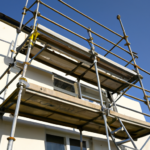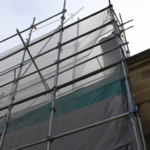Are you ready to start a building project and eager to see your idea come to life? Before you begin, it is important to consider the foundation on which your goals will be based. The importance of professional scaffolding installation in the UK cannot be overstated.
When planning to build upwards, it is crucial to prioritize your safety and ensure the structural integrity of your plan by constructing and installing each component meticulously.
This article will explain why it is essential to trust professionals with the task of scaffolding installation. By adhering to regulations and standards, these experts guarantee your well-being and compliance with legal requirements. They also possess the knowledge and expertise necessary for proper load distribution and stability, preventing accidents that could jeopardize lives and hinder progress.
Join us as we delve into the world of professional scaffolding installation in the UK, discovering the key to employee safety, maximizing productivity, and ultimately freeing yourself from unnecessary risks.
Ensuring Worker Safety
You will be pleased to know that worker safety is a major priority when it comes to professional scaffolding installation in the UK. Training and equipment maintenance play essential roles, and every effort is made to create a safe working environment.
Detailed training programmes are put in place to teach workers the correct techniques for erecting and dismantling scaffolding, as well as the importance of fall protection measures. This extensive training equips workers with the knowledge and expertise needed to tackle potential risks confidently.
Additionally, regular equipment maintenance is conducted to make sure that all components of the scaffolding system are in optimal condition. This involves inspections for any signs of wear or damage, and swift repairs or replacements when necessary.
By emphasising worker safety through training and equipment maintenance, professional scaffolding installation companies in the UK demonstrate their dedication to providing a secure workspace for all involved.
Compliance with Regulations and Standards
When it comes to complying with regulations and standards, it is important to ensure that the setup of your scaffolding in the United Kingdom meets all necessary criteria.
The Health and Safety at Work Act 1974 outlines the legal requirements for scaffolding installation, emphasizing that it should be carried out by knowledgeable professionals. Hiring a professional scaffolding installation company can ensure that your structure adheres to all laws and standards.
These companies are well-versed in current legislation and trained to identify potential risks associated with scaffolds. Additionally, they will conduct inspections throughout the process to ensure ongoing compliance.
Investing in professional installation not only guarantees the safety of workers but also protects you from potential legal issues and financial penalties that may arise from non-compliance.
Proper Load Distribution and Stability
To ensure the stability and safety of your scaffold structure, it is important to distribute the load evenly throughout its framework. Conducting a load capacity analysis is crucial in determining the maximum weight that a scaffold can bear without compromising its structural integrity. This analysis helps identify any potential weak points or areas of concern in the scaffold design.
Another important aspect of ensuring proper load distribution is conducting a structural stability assessment. This assessment involves evaluating the overall strength and stability of the scaffold structure to withstand various loads and forces. By conducting a thorough assessment, you can identify potential risks and take necessary measures to reinforce weak areas.
Proper load distribution and structural stability are essential in preventing accidents, injuries, and damage to property. They ensure that your scaffold can safely support workers, tools, and materials during construction or maintenance activities. By following load capacity analysis and conducting regular structural stability assessments, you can have confidence in the safety and reliability of your scaffolding installation.
Preventing Accidents and Injuries
Preventing accidents and injuries requires a thorough understanding of scaffold safety measures. It is essential to prioritize the prevention of falls, which can cause severe harm or even death. Training is critical to ensure employees possess the knowledge and abilities to detect potential hazards and take necessary precautions.
By incorporating comprehensive safety training programmes, employers can give their workforce the opportunity to make informed decisions when working at heights.
To avoid falls, implementing fall protection systems such as guardrails, personal fall arrest systems, or safety nets is essential. Additionally, regular inspections of scaffolding equipment should be conducted to check its structural stability and identify any possible problems that could compromise worker safety.
Preventing accidents and injuries on scaffolding sites requires a proactive approach focused on appropriate safety training and the implementation of fall protection systems. Adhering to these measures allows workers to carry out their tasks with confidence while reducing the risk of accidents.
Maximising Efficiency and Productivity
Maximise your efficiency and productivity on scaffolding sites by implementing effective strategies and utilising time-saving techniques. To improve construction processes and minimise downtime, consider the following:
- Streamline workflows: Identify bottlenecks in your current processes and find ways to eliminate unnecessary steps or streamline tasks. This will help ensure smooth operations and reduce wasted time.
- Utilise advanced tools and equipment: Invest in high-quality tools that are specifically designed for scaffolding work. These tools can enhance productivity by making tasks easier, faster, and more accurate.
- Plan ahead: Develop a detailed plan before starting any project. This includes scheduling tasks, allocating resources, and coordinating with other teams involved in the construction process. Proper planning helps prevent delays and ensures a smooth workflow.
By adopting these strategies, you can significantly improve your efficiency on scaffolding sites while minimising downtime, leading to increased productivity overall.
Frequently Asked Questions
What qualifications and certifications are needed for professional scaffolding installation in the UK?
To professionally install scaffolding in the UK, you need to meet specific qualifications and certifications. This involves adhering to professional standards and safety measures to ensure compliance with regulations.
It is important to implement adverse weather protocols and conduct regular hazard inspections to maintain a safe working environment.
Additionally, it is crucial to closely adhere to power line guidelines to prevent accidents.
By following these requirements, you will ensure the structural integrity of your scaffolding and avoid any compliance consequences.
How frequently should scaffolding undergo inspection for possible hazards or defects?
Scaffolding inspection frequency is crucial for identifying potential hazards or defects. It is recommended to conduct regular inspections to ensure the safety of personnel and prevent accidents.
Common risks in scaffolding include instability, insufficient bracing, incorrect assembly, and inadequate fall protection. Inspections should be carried out prior to initial use, weekly thereafter, after adverse weather conditions, and following any modifications.
Thoroughly examining all components for signs of wear and tear will help maintain a safe working environment and minimize risks associated with the use of scaffolding.
Are there any specific guidelines for installing scaffolding near power lines or other hazardous areas?
While some may argue that safety guidelines for scaffolding installation near power lines are unnecessary, it is essential to prioritize the well-being of workers and prevent potential accidents. Professional scaffolding installation best practices emphasise the importance of maintaining a safe distance from power lines to avoid the risk of electrocution.
Ensuring the structural integrity of the scaffolding requires strict adherence to these safety measures. They not only protect lives but also provide workers with a sense of relief from the fear of working in hazardous areas.
What are the implications of not complying with scaffolding regulations and standards?
Noncompliance with scaffolding regulations and standards can have serious consequences. Inadequate scaffolding can result in accidents, injuries, or even fatalities for workers. It could also cause damage to property and equipment.
Regular maintenance is crucial to ensure the stability and strength of the scaffold structure. Following regulations and conducting regular inspections can minimize risks and establish a safe working environment. Prioritizing proper installation and maintenance is vital for the overall success of any construction project.
Are there any specific safety measures or protocols that should be followed when working on scaffolding in adverse weather conditions?
When operating scaffolding in adverse weather conditions, it is important to follow strict safety measures and protocols. Adequate training is necessary to safely navigate challenging weather conditions.
In order to minimize the risk of accidents or injuries, it is crucial to properly secure the scaffolding, use non-slip surfaces, and wear appropriate protective equipment. By adhering to these guidelines, the welfare of workers can be ensured.
Thanks for reading, please do check out our other posts and services below:











